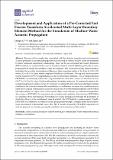Development and application of a pre-corrected fast Fourier transform accelerated multi-layer boundary element method for the simulation of shallow water acoustic propagation
Author(s)
Li, Chengxi; Lian, Jijian
Downloadapplsci-10-02393-v2.pdf (7.748Mb)
Publisher with Creative Commons License
Publisher with Creative Commons License
Creative Commons Attribution
Terms of use
Metadata
Show full item recordAbstract
Because of the complexities associated with the domain geometry and environments, accurate prediction of acoustics propagation and scattering in realistic shallow water environments by direct numerical simulation is challenging. Based on the pre-corrected Fast Fourier Transform (PFFT) method, we accelerated the classical boundary element method (BEM) to predict the acoustic propagation in a multi-layer shallow water environment. The classical boundary element method formulate the acoustics propagation problem as a linear equation system in the form of [A]{x}={b}, where [A] is an N×N dense matrix composed of influence coefficients. Solving such linear equation system requires O(N2 /N3 ) computational cost for iterative/direct methods. The developed method, PFFT-BEM, can effectively reduce the computational efforts for direct numerical simulations from O(N2~3) to O(Nlog N), where N is the total number of boundary unknowns. To numerically simulate the sound propagation in a shallow water environment, we applied the first-order non-reflecting boundary condition in the truncated numerical domain boundary to eliminate the errors due to reflected waves. Multi-layer coupled formulation was used to include the environment inhomogeneity in PFFT-BEM. Through multiple convergence tests on the number of layers and elements, we validated and quantified the accuracy of PFFT-BEM. To demonstrate the usefulness and capability of the developed PFFT-BEM, we simulated three-dimensional (3D) underwater sound propagation through 3D geometries to check the efficacy of the established classical method: the 3D Parabolic equation model. Finally, PFFT-BEM was employed to simulate sound propagation through a complex multi-layer shallow water environment with internal waves. The "3D+T" results obtained by PFFT-BEM compared well with the physical test, thereby proving the capability and correctness of this method. ©2020 Keywords: ocean acoustics; boundary element method; pre-corrected fast Fourier transform method; multilayer formulation
Date issued
2020-04Department
Massachusetts Institute of Technology. Department of Mechanical EngineeringJournal
Applied Sciences
Publisher
Multidisciplinary Digital Publishing Institute
Citation
Li, Chengxi, and Jijian Lian, "Development and application of a pre-corrected fast Fourier transform accelerated multi-layer boundary element method for the simulation of shallow water acoustic propagation." Applied Sciences 10, 7 (Apr. 2020): no. 2393 doi 10.3390/app10072393 ©2020 Author(s)
Version: Final published version
ISSN
2076-3417